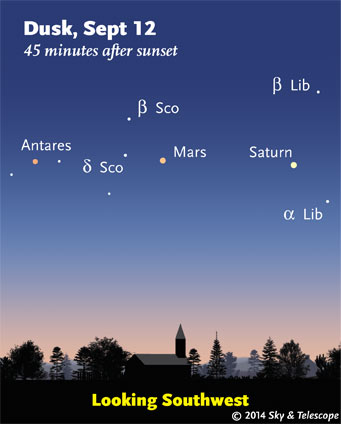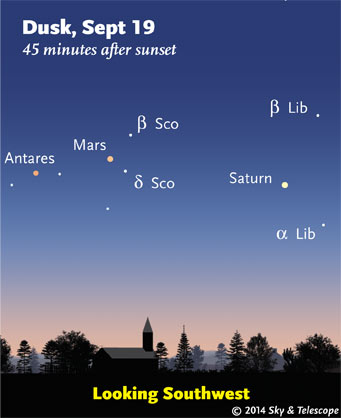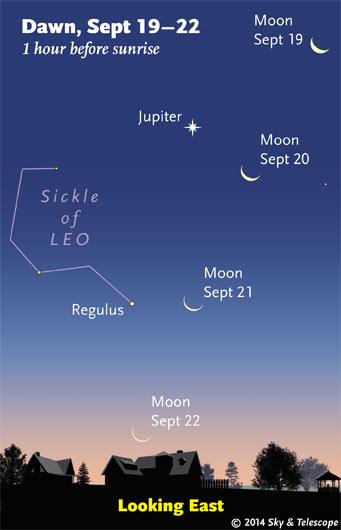Friday, September 12
Auroras tonight? And possibly Saturday night? A coronal mass ejection from the Sun hit the Earth around 8 this morning Eastern Daylight Time (12:00 UT), and another arrived a few hours later. They were not as strong as expected, but their effects may continue for more than a day. See our article: Potent Solar Flare — Auroras Friday?. And check for recent photos.

In the southwestern sky at dusk, Antares, Mars, and Saturn now form an almost equally spaced straight line, as shown at right. Mars continues to move east against its starry background. Watch for it to pass ½° north of Delta Scorpii on September 17th and 3° north of Antares on the 27th and 28th.
This evening one of Saturn's moons, 10th-magnitude Rhea, will occult (cover up) a much brighter star, 7.8 magnitude SAO 159034, for much of eastern North America. Details and illustrations are in our article, See Saturn’s Moon Rhea Hide a Star.
Saturday, September 13
How soon after sunset can you make out the big Summer Triangle? Vega, its brightest star, is nearly at the zenith (for skywatchers at mid-northern latitudes). Deneb is the first bright star to Vega's east-northeast. Altair shines less high in the southeast.
Sunday, September 14
If you have a dark sky and a scope that can reach 13th-magnitude galaxies, here's an observing project you've probably never thought of: Steve Gottlieb's "Going Deep" tour of Vorontsov-Velyaminov galaxy pairs now high in the evening sky. See the September Sky & Telescope, page 60, with charts and pictures.
Monday, September 15
Last-quarter Moon (exactly last-quarter at 10:05 p.m. EDT). The Moon rises around midnight tonight under the horn-tips of Taurus. It stands high in the south over Orion by Tuesday's dawn.
Tuesday, September 16
Arcturus is the bright star fairly high due west at nightfall. It's an orange giant 37 light-years away. Off to its right in the northwest is the Big Dipper, most of whose stars are about 80 light-years away.
Wednesday, September 17
Mars is just ½° above fainter Delta Scorpii after dusk.
Algol in Perseus, the prototype eclipsing variable star, should be at its minimum light, magnitude 3.4 instead of its usual 2.1, for a couple hours centered on 11:06 p.m. Pacific Daylight Time. It takes several additional hours to fade and to rebrighten.
Thursday, September 18
Got sharp eyes? Or glasses that turn your eyes sharp? Try Steve Gottlieb's "20 Fun Naked-Eye Double Stars" in the September Sky & Telescope, page 64.

Friday, September 19
At dawn Saturday morning, Jupiter shines upper left of the waning Moon in the east. How long has it been since you turned your scope on either Jupiter or the waning crescent?
Saturday, September 20
Algol should be at its minimum light again for a couple of hours centered on 10:55 p.m. EDT.
In early dawn on Sunday the 21st, the waning crescent Moon shines far below Jupiter and closer to the right of Regulus.
Want to become a better astronomer? Learn your way around the constellations. They're the key to locating everything fainter and deeper to hunt with binoculars or a telescope.
This is an outdoor nature hobby; for an easy-to-use constellation guide covering the whole evening sky, use the big monthly map in the center of each issue of Sky & Telescope, the essential guide to astronomy. Or download our free Getting Started in Astronomy booklet (which only has bimonthly maps).

Once you get a telescope, to put it to good use you'll need a detailed, large-scale sky atlas (set of charts). The standards are the little Pocket Sky Atlas, which shows stars to magnitude 7.6; the larger and deeper Sky Atlas 2000.0 (stars to magnitude 8.5); and once you know your way around, the even larger Uranometria 2000.0 (stars to magnitude 9.75). And read how to use sky charts with a telescope.
You'll also want a good deep-sky guidebook, such as Sue French's Deep-Sky Wonders collection (which includes its own charts), Sky Atlas 2000.0 Companion by Strong and Sinnott, the bigger Night Sky Observer's Guide by Kepple and Sanner, or the beloved if dated Burnham's Celestial Handbook.
Can a computerized telescope replace charts? Not for beginners, I don't think, and not on mounts and tripods that are less than top-quality mechanically (able to point with better than 0.2° repeatability, which means fairly heavy and expensive). As Terence Dickinson and Alan Dyer say in their Backyard Astronomer's Guide, "A full appreciation of the universe cannot come without developing the skills to find things in the sky and understanding how the sky works. This knowledge comes only by spending time under the stars with star maps in hand."
This Week's Planet Roundup

Mercury (magnitude 0.0) remains quite deep in the sunset. Scan for it with binoculars just above the west-southwest horizon about 20 minutes after sundown. Don't confuse it with twinklier Spica right in the same vicinity. They appear closest together from September 19th to 21st.
Venus (magnitude –3.9) and Jupiter (magnitude –1.9) shine in the east during dawn. They continue moving farther apart each day: Jupiter is moderately high now, but Venus has sunk very low far to Jupiter's lower left. It's still below the horizon an hour before sunrise in the illustration here.
Mars and Saturn (magnitudes +0.7 and +0.6, respectively) glow in the southwest at dusk, moving farther apart day by day. Saturn is the one on the right. To Mars's left is its starry namesake, Antares ("Anti-Mars" in Greek).
Uranus (magnitude 5.7, in Pisces) and Neptune (magnitude 7.8, in Aquarius) are high in the southeast and south, respectively, by 11 or midnight. See our Finder charts for Uranus and Neptune online or in the September Sky & Telescope, page 50.
All descriptions that relate to your horizon — including the words up, down, right, and left — are written for the world's mid-northern latitudes. Descriptions that also depend on longitude (mainly Moon positions) are for North America.
Eastern Daylight Time (EDT) is Universal Time (UT, UTC, or GMT) minus 4 hours.
“This adventure is made possible by generations of searchers strictly adhering to a simple set of rules. Test ideas by experiments and observations. Build on those ideas that pass the test. Reject the ones that fail. Follow the evidence wherever it leads, and question everything. Accept these terms, and the cosmos is yours.”
— Neil deGrasse Tyson, 2014.
 1
1
Comments
September 18, 2014 at 1:56 pm
"Can a computerized telescope replace charts?"
Actually I think it can. Check out Stellarium, install ASCOM drivers for your scope. I believe that this setup can replace your charts although they are still handy to keep around.
You must be logged in to post a comment.
You must be logged in to post a comment.